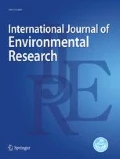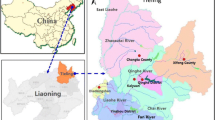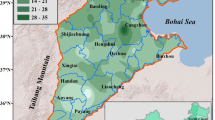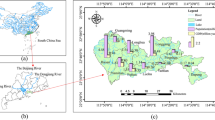Abstract
One of the key issues in managing water and energy systems is to incorporate the links between these systems to ensure security of resources. In this research, using system dynamics (SD) approach for simulating water–energy (WE) nexus, SD-WE model was developed for 16 sub-basins of Gavkhuni basin in central Iran. Various water- and energy-saving policies were simulated and their effectiveness in improving resource security was evaluated using water- (WSI) and energy-saving (ESI) indices. The results indicated that the share of water-related energy consumption (20%, 6%, and 2% of total electricity, crude oil, and natural gas consumption) is higher than the energy-related water withdrawal (17% of industrial water withdrawal) in the basin-wide resource usage. The water-saving policies had a significant impact on both the basin’s energy and water resources. In contrast, energy-saving policies had a negligible influence on the basin’s water resources but a notable impact on the water resources used in the energy sector outside of the basin. In addition, SD-WE model simulations showed that agriculture was the most effective end-user on resource saving, by improving WSI and ESI as much as 22% and 5.7%, respectively. Finally, the results of this study indicated that SD-WE model can be used as a tool to illustrate the inter-linkages, synergies, and trade-offs between water and energy systems, where limited water and energy data are available and also can be used as a platform for water–energy nexus modeling in other basins.
Research Highlights
-
A system dynamics approach for simulating water–energy nexus was introduced.
-
Water-related policies had a significant impact on both energy and water resources of the case study area.
-
Energy-related policies had a negligible influence on water resources of the case study area.









Similar content being viewed by others
Data Availability Statement
Summary of data used is provided in the context and the appendices and more details are available from the corresponding author by request.
References
Bakhshianlamouki E, Masia S, Karimi P, van der Zaag P, Sušnik J (2020) A system dynamics model to quantify the impacts of restoration measures on the water–energy–food nexus in the Urmia lake Basin, Iran. Sci Total Environ 708:134874. https://doi.org/10.1016/j.scitotenv.2019.134874
Bazilian M, Rogner H, Howells M, Hermann S, Arent D, Gielen D, Steduto P, Mueller A, Komor P, Tol RSJ, Yumkella KK (2011) Considering the energy, water and food nexus: towards an integrated modelling approach. Energy Policy 39(12):7896–7906. https://doi.org/10.1016/j.enpol.2011.09.039
Brown GO (2002) The history of the Darcy–Weisbach equation for pipe flow resistance. Proc Environ Water Resour Hist. https://doi.org/10.1061/40650(2003)4
de Vito R, Portoghese I, Pagano A, Fratino U, Vurro M (2017) An index-based approach for the sustainability assessment of irrigation practice based on the water-energy-food nexus framework. Adv Water Resour 110:423–436. https://doi.org/10.1016/j.advwatres.2017.10.027
de Vito R, Pagano A, Portoghese I, Giordano R, Vurro M, Fratino U (2019) Integrated approach for supporting sustainable water resources management of irrigation based on the WEFN framework. Water Resour Manag 33(4):1281–1295. https://doi.org/10.1007/s11269-019-2196-5
Duan C, Chen B (2017) Energy-water nexus in Beijing: causality analysis and scenario analysis. Energy Proced 105:3966–3971. https://doi.org/10.1016/j.egypro.2017.03.826
Feng C, Tang X, Jin Y, Höök M (2019) The role of energy-water nexus in water conservation at regional levels in China. J Clean Prod 210(2019):298–308. https://doi.org/10.1016/j.jclepro.2018.10.335
Forrester JW (1997) Industrial dynamics. J Oper Res Soc 48(10):1037–1041
Forrester JW (2007) System dynamics—a personal view of the first 50 years. Syst Dyn Rev J Syst Dyn Soc 23(2–3):345–358. https://doi.org/10.1002/sdr.382
Gadonneix P, de Castro FB, de Medeiros NF, Drouin R, Jain CP, Kim YD, Ferioli J, Nadeau MJ, Sambo A, Teyssen J (2010) Water for energy. World Energy Council. https://www.worldenergy.org/assets/downloads/PUB_Water_For_Energy_2010_WEC.pdf
Gao J, Li C, Zhao P, Zhang H, Mao G, Wang Y (2019) Insights into water-energy cobenefits and trade-offs in water resource management. J Clean Prod 213:1188–1203. https://doi.org/10.1016/j.jclepro.2018.12.126
Gleick PH (1994) Water and energy. Annu Rev Energy Environ 19(1):267–299
Golmohammadi M (2015) Scenario analysis for integrated water resources planning and management (IWRPM) under uncertainty using fuzzy performance criteria and sustainability index. Doctorate thesis, Department of Civil Engineering, Isfahan University of Technology
Guo Y, Tian J, Chen L (2020) Water-energy nexus in China’s industrial parks. Resour Conserv Recycl 153:104551. https://doi.org/10.1016/j.resconrec.2019.104551
Hoekstra AY, Chapagain AK (2007) Water footprints of nations: water use by people as a function of their consumption pattern. Water Resour Manag 21(1):35–48. https://doi.org/10.1007/s11269-006-9039-x
Hoff H (2011) Understanding the nexus: background paper for the Bonn 2011 Nexus Conference. SEI
IUT (2013) Land use planning and strategic document development of Isfahan province, water resources. Isfahan University of Technology, Iran
IUT (2014) Land use planning and strategic document development of Isfahan province, energy. Isfahan University of Technology, Iran
Larsen SG (2010) Determining energy requirement for future water supply and demand alternatives. Master of Science thesis, Civil and Environmental Engineering, University of Utah. https://core.ac.uk/download/pdf/276265811.pdf
Li X (2014) Understanding the water-energy nexus: a case study of Ningxia. Master thesis in Sustainable Development, Uppsala University, Department of Earth Sciences. https://www.diva-portal.org/smash/get/diva2:747151/FULLTEXT01.pdf%0A
Lin J, Kang J, Bai X, Li H, Lv X, Kou L (2019b) Modeling the urban water-energy nexus: a case study of Xiamen, China. J Clean Prod 215:680–688. https://doi.org/10.1016/j.jclepro.2019.01.063
Lin J, Kang J, Bai X, Li H, Lv X, Kou L (2019a) Modeling the urban water-energy nexus: a case study of Xiamen, China. J Clean Prod 215:680–688
Liu L, Hejazi M, Patel P, Kyle P, Davies E, Zhou Y, Clarke L, Edmonds J (2015) Water demands for electricity generation in the U.S.: modeling different scenarios for the water-energy nexus. Technol Forecast Soc Change 94:318–334. https://doi.org/10.1016/j.techfore.2014.11.004
Madani K, Mariño MA (2009) System dynamics analysis for managing Iran’s Zayandeh-rud river basin. Water Resour Manag 23(11):2163–2187. https://doi.org/10.1007/s11269-008-9376-z
Marsh DM (2008) The water-energy nexus: a comprehensive analysis in the context of New South Wales. Doctor of Philosophy thesis, Engineering and Information Technology, University of Technology, Sydney. https://opus.lib.uts.edu.au/bitstream/2100/1075/2/02Whole.pdf
Mo W (2012) Water’s dependence on energy: analysis of embodied energy in water and wastewater systems. Graduate theses and dissertations, Civil and Environmental Engineering, University of South Florida. http://scholarcommons.usf.edu/etd/4374
Mohtar RH, Daher B (2016) Water-energy-food nexus framework for facilitating multi-stakeholder dialogue. Water Int 41(5):655–661. https://doi.org/10.1080/02508060.2016.1149759
Newell JP, Goldstein B, Foster A (2019) A 40-year review of food–energy–water nexus literature and its application to the urban scale. Environ Res Lett 14(7):73003. https://doi.org/10.1088/1748-9326/ab0767
OPEE (2011) Energy balance of the year 2010. Office of Planning for Electricity and Energy, Iran
OPEE (2016) Energy balance of the year 2014. In Office of Planning for Electricity and Energy, Iran
OPWW (2014) Statistical yearbook of water, 2010–2011. In Office of Planning for Water and Wastewater, Ministry of Energy, Iran. http://library1.nida.ac.th/termpaper6/sd/2554/19755.pdf
Plappally AK, Lienhard VJH (2012) Energy requirements for water production, treatment, end use, reclamation, and disposal. Renew Sustain Energy Rev 16(7):4818–4848. https://doi.org/10.1016/j.rser.2012.05.022
Purwanto A, Sušnik J, Suryadi FX, de Fraiture C (2019) Using group model building to develop a causal loop mapping of the water-energy-food security nexus in Karawang Regency, Indonesia. J Clean Prod 240:118170. https://doi.org/10.1016/j.jclepro.2019.118170
Ravar Z, Zahraie B, Sharifinejad A, Gozini H, Jafari S (2020) System dynamics modeling for assessment of water–food–energy resources security and nexus in Gavkhuni basin in Iran. Ecol Ind. https://doi.org/10.1016/j.ecolind.2019.105682
Siddiqi A, Anadon LD (2011) The water-energy nexus in Middle East and North Africa. Energy Policy 39(8):4529–4540. https://doi.org/10.1016/j.enpol.2011.04.023
Sterman J (2002) System dynamics: systems thinking and modeling for a complex world
System Dynamic Society (2020) What is system dynamics? https://systemdynamics.org/what-is-system-dynamics/
Thornthwaite CW (1948) An approach toward a rational classification of climate. Geogr Rev 38(1):55. https://doi.org/10.2307/210739
Tavanir Organization (2015) Detailed statistics of Iran’s power generation industry, energy production in the year 2014. Tavanir Organization, Iran
Vilanova MRN, Balestieri JAP (2015) Exploring the water-energy nexus in Brazil: the electricity use for water supply. Energy 85:415–432. https://doi.org/10.1016/j.energy.2015.03.083
YCE (2012) Updating studies of comprehensive water plan of country in Daryacheh Namak, 74 Gavkhuni, Siahkuh-Rigrazin, and Kavir Markazi Basins. Gavkhuni Basin. Yekom Consulting 75 Engineers, Office of Planning for Water and Wastewater, Ministry of Energy, Iran
YCE (2013) Updating studies of comprehensive water plan of country in Daryacheh Namak, 77 Gavkhuni, Siahkuh-Rigrazin, and Kavir Markazi Basins. Gavkhuni Basin. Yekom Consulting 78 Engineers, Office of Planning for Water and Wastewater, Ministry of Energy, Iran
ZCE (2014) Study of water resources balance of Gavkhuni Basin. Regional Water Company of Isfahan, Iran
ZCE (2015) Updating studies of water resources balance in Gavkhuni basin’s sub-basins in the year 2010–2011. In: Volume 5: Assessment of water resources. Zayandab Consulting Engineers, Regional Water Company of Isfahan, Ministry of Energy, Iran
Zhang C, Chen X, Li Y, Ding W, Fu G (2018) Water-energy-food nexus: concepts, questions and methodologies. J Clean Prod 195:625–639. https://doi.org/10.1016/j.jclepro.2018.05.194
Zhuang Y (2014) A system dynamics approach to integrated water and energy resources management. Graduate theses and dissertations, Civil and Environmental Engineering, University of South Florida. https://scholarcommons.usf.edu/etd/5164/
Funding
This study has been supported by the Iran National Science Foundation (INSF) [Grant number 96005981]. Support of INSF is hereby acknowledged.
Author information
Authors and Affiliations
Corresponding author
Ethics declarations
Conflict of interest
The authors declare that they have no conflict of interest.
Supplementary Information
Below is the link to the electronic supplementary material.
Rights and permissions
About this article
Cite this article
Gozini, H., Zahraie, B. & Ravar, Z. System Dynamics Modeling of Water–Energy Nexus for Resource-Saving Policy Assessment. Int J Environ Res 15, 349–367 (2021). https://doi.org/10.1007/s41742-021-00321-5
Received:
Revised:
Accepted:
Published:
Issue Date:
DOI: https://doi.org/10.1007/s41742-021-00321-5




